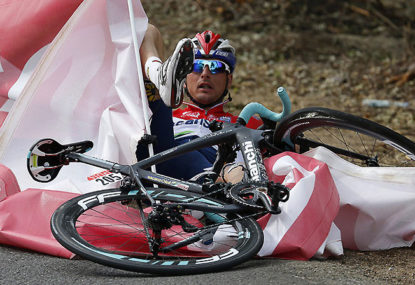'I've just won a stage of the Tour de France, mate!': Hindley grabs yellow jersey as Aussie blows Tour apart
Australia's Jai Hindley has said he is "lost for words" after a shock stage victory at the Tour de France earned him the leader's…

The blame game had already begun as the bruised and battered riders unfortunate enough to be caught up in the crashes that marred stage one of this year’s Tour de France crossed the line, in dribs and drabs and varying states of repair.
The major crash, which wiped out the chances of most of the key sprinters including Mark Cavendish (Omega Pharma-Quickstep) and Peter Sagan (Cannondale) and left Tony Martin (Omega Pharma-Quickstep) so smashed up that he passed out twice in the team bus afterwards, was ugly to watch.
Smaller incidents both before and after the major crash also cost some riders dearly.
In separate incidents earlier, Johnny Hoogerland (Vacansoleil) and Ryder Hesjedal (Garmin Sharp) both tangled with the roadside barriers, while Matt Goss (Orica GreenEDGE) clipped one and came to grief with only 500 metres to go.
In the background, but no less a player in the whole affair, was the Orica-GreenEDGE team bus, which had wedged itself beneath the banner and timing device structure at the finish line.
With the riders barely twelve kilometres away and closing fast a decision had to be made – and quickly.
With little option seemingly available to them, the race jury decided to move the finish to the three kilometre to go mark where they already had photographic equipment set up to record the order of the placings.
Soon after, with the bus managing to wriggle free of its predicament, word went out that the original race finish would be reinstated.
Mayhem ensued.
A wild Cavendish, annoyed at losing his chance to contest not only the stage win but the first yellow jersey of the Tour, was in no doubt as to where the blame lay.
“What caused the problems was changing the finish. Like we heard in the radios at literally five kilometres to go that the sprint was in two kilometres,” he said.
“Then a kilometre later, no, it’s at the finish. Then it was carnage.”
Former French national champion and FDJ sprinter Nacer Bouhanni was also left confused by the chopping and changing of the race officials.
“It’s not normal that they just change like that. I managed to avoid crashes, but I didn’t know where the finish was any more, three kilometres out or on the original finish line,” he said.
“I tried to stay at the front without even knowing.”
His manager at FDJ, Marc Madiot was even more scathing.
“It’s a complete nonsense. The president of the (race) jury should get a big fine,” he said.
“The riders took risks to get into position for the amended finish three kilometres from the line, and then they changed their minds.
“Why did the president of the jury change his mind?
“When we make mistakes we get punished, so the president of the jury should also assume responsibility for his actions…he should be sent home tonight.”
While having the finishing line move during the closing stages of a race must be disturbing for riders and teams trying to jockey their sprinters into position, not all the blame can be laid at the feet of the race organisers.
Hesjedal, who was caught up in a smaller crash earlier, blamed inconsistently placed barriers and inattentive riders for his problems.
“The roads are fine, but guys were crashing into the barriers. They were there and then not there, so all of a sudden, if you have your bars in a certain place, too far to the left, you’ve got to take account of the barriers,” he said.
“If guys aren’t paying attention, they hit the barriers.”
Jerome Pineau (Omega Pharma-Quickstep) had yet another take on matters, placing his blame squarely at the feet of the sports biggest names – the general classification riders.
As has been the growing trend over the past few seasons, the men chasing overall victory have been encroaching into the sprinters’ territory towards the end of each flat stage.
Unwilling to sit back in the pack and potentially lose time and skin because of a crash, they too are racing forward, often behind ‘trains’ of their own, leaving the pointy end of the bunch crowded and cramped for room.
Throw roundabouts and road furniture into the mix as well as over enthusiastic spectators, and doubts about the actual placement of the finish line, and you have a recipe for disaster.
But would it have been any different had the Orica-GreenEDGE bus passed safely under the now infamous banner and not blocked the road?
Probably not.
The opening stages of the Tour de France are notorious for crashes.
Nervous, twitchy, adrenalin fuelled young men with ambitions of glory, all eager to start their Tours off on a positive note, are not known for their care and gentleness when racing in excess of 60 kilometres an hour to achieve their goal.
They fight for position. They bump and bustle. They overcook corners. They suffer mechanicals.
The closing stages of a bike race are brutal, especially those ending in a bunch sprint, and it is not for the faint hearted.
Crashes occur. It is what happens when 198 cyclists start fighting for the same piece of road.
Saturday’s crashes were unfortunate. They robbed the public of a showdown between the world’s fastest men, and yet bus or no bus, barriers or no barriers, GC men or no GC men, they may have happened anyway.
In the end the bus was moved, the race reached its conclusion and Marcel Kittel (Argos-Shimano) took a deserving win.
Time to move on.